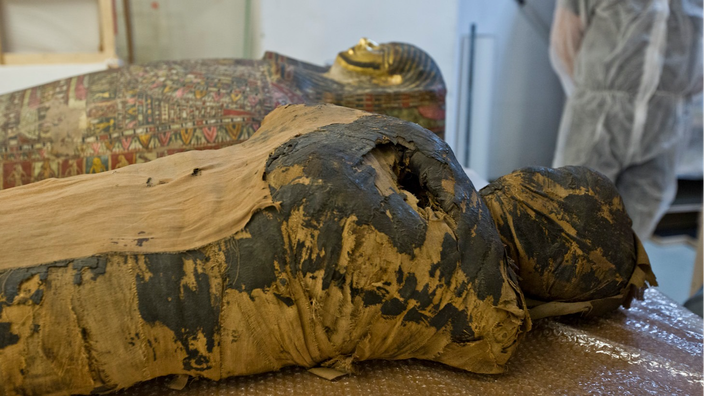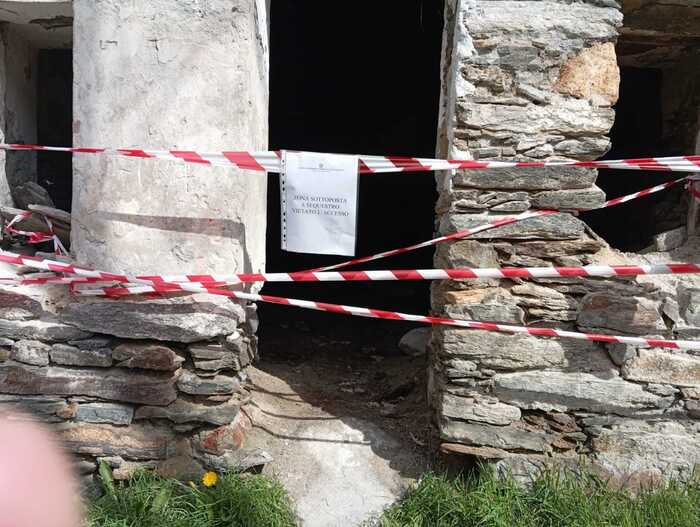It is a mistake from beyond the grave. An Egyptian mummy from the 1st century BC. AD, preserved in Warsaw had been identified with confidence, after the deciphering in 1929 of the hieroglyphics of his coffin, as being that of the noble Hor-Djehuty, Theban priest of Horus-Thot, singer of Montu and royal governor by Petmiten. An important dignitary of Greco-Roman Egypt. Almost a century later, however, Polish Egyptologists discovered a point of anatomical detail that had escaped their elders: still wrapped in his funeral wraps, the deceased revealed to relentless Warsaw scanners that he actually did not have that very little to do with what presented the Egyptian texts which protected it.
"Our first surprise was to find that the mummy did not have a penis, but breasts and long hair
,
"
Marzena Ozarek-Szilke told the Associated Press.
And for good reason.
“My husband Stanislaw, Egyptologist, and I looked at the scanned images and noticed a vision which seemed very familiar, for parents of three children, in the womb of the deceased woman: a small foot”,
specified the archaeologist. anthropologist from the University of Warsaw for the Polish News Agency (PAP).
In the absence of the priest Hor-Djehuty, the coffin kept for two centuries in Warsaw contained a pregnant woman.
The first ever mummified discovery.
Read also: Pharaonic show for the unprecedented parade of 22 royal mummies in Cairo
A young woman 6 to 7 months pregnant
Correctly identified in 2016 as a female rather than a male remains, this pregnant mummy mummified with her fetus is the first of its kind.
“For unknown reasons, the fetus was not removed from the abdomen of the deceased during mummification. This is what makes this mummy so unique, ”
explained Wojciech Ejsmond of the Polish Academy of Sciences, who co-authored with Marzena Ozarek-Szilke, the study of the mummy which had just appeared in the
Journal of Archaeological Science.
. Because if we have already discovered the skeletons of pregnant women, the mysterious Egyptian from Warsaw is to date the only person to have been the subject of an embalming in full pregnancy with her fetus. Why, then, not have it extracted during the long process of mummification, as one would expect?
According to the researchers, this exceptional case could be either the consequence of a medical difficulty linked to the extraction of the fetus at this precise stage of the pregnancy, or a voluntary concealment process. Unless it's a religious reason. Died between the 26th and 30th week of pregnancy, this mummified woman was in her twenties at the time of her death. The cause of his death is not yet known, although Polish Egyptologists suspect a complication related to his condition.
"It is no secret that the death rate at that time was also high during pregnancy and childbirth,"
said Wojciech Ejsmond for PAP, specifying that traces of blood had been identified on a part. fabrics.
The pregnant mummy is not the first occupant of the coffin, originally intended for a Theban priest.
B. Bajerski / Muzeum Narodowe w Warszawie
A reused coffin?
Could this woman have been the priest, or the priestess for that matter, mentioned by the hieroglyphics of the coffin? Probably not, archaeologists argue, who speculate that all of the funerary formwork - the coffin and cardboard box covering the mummy - may well not be related to the remains. Indeed, the radiological analysis carried out in recent years in Warsaw has shown that both the coffin and the funerary cardboard were made for a mummy other than the one that has been there since at least the 19th century. It had been acquired by a Polish traveler who donated it to the University of Warsaw in 1826 (who in turn transmitted it in 1917 on deposit to the National Museum in Warsaw), while the wave of Egyptomania and Orientalism is in full swing in Europe.
Read also: An orientalist pastel by Eugène Delacroix at auction on March 24
With the times in question ripe for scams, Polish scientists have suggested that it may be a modern manipulation carried out by 19th century traffickers.
“Illegal excavations, looting of mummies, partial unpacking for valuables, then repacking, 'embellishing' and putting back in coffins (not necessarily the same ones the mummy had been in). found) were common practices in the 19th century ”
, recalled the researchers, who believe that nearly 10% of sarcophagi exposed in the world would not contain their original occupants.
Since the dating of the mummy however corresponds to that of its current casing, archaeologists remain hopeful that the anonymous deceased originated from the same Theban necropolis as the priest of Horus-Thoth, even if nothing is certain.
An older permutation of the formwork, for example linked to an ancient re-use, is not excluded either.
The Lady of Warsaw has been inspected by various scientific and medical scanners.
O. Leydo / Muzeum Narodowe w Warszawie
The discovery of this pregnant woman is part of a non-invasive study campaign of the forty or so human and animal mummies kept at the National Museum in Warsaw. Started in 2015, this research program called Warsaw Mummy Project covers a series of scanner inspections and 3D restorations of Egyptian remains from the Polish capital; a method which makes it possible to analyze the deceased as closely as possible without risking damage to them during handling. Unlike the fetus, which is relatively inconspicuous, the sex of the mummy could in this way be easily identified, the researchers involved willingly mentioning in their various interviews the
"delicate constitution"
, the breasts and the
"long curly hair, falling to the bottom. shoulders "
of the deceased digitally restored.
Read also: In Egypt, the mummy of a pharaoh reveals his secrets thanks to science
As the Polish archaeologists mentioned in their scientific publication, the pregnant mummy from Warsaw opens up several interesting perspectives for research, whether in the study of pregnancy in ancient Egypt, or - in the field of ancient beliefs - on the possibility, for the fetuses, to reach the beyond. "
Maybe they thought that the unborn child had no soul or that it would be
safer in
the other world,
" Wojtek Ejsmond asked in an interview with CNN. In an exchange with Live Science, the archaeologist clarified that, not being born, the fetus had probably not received a name, probably barring its entry to the domain of the dead and Osiris:
"Her life after death could only have taken place by going to the underworld in her mother's womb"
.
Finally, the question of the identity of the deceased remains: since it was not the priest Hor-Djehuty, who was therefore the anonymous buried?
According to the very high quality of the embalming, and the precious amulets slipped along the body, the mummy was certainly a woman of high rank from the 1st century BC.
AD, possibly of Theban origin.
Beyond these meager clues, the pregnant Lady of Warsaw risks keeping her most fruitful mysteries wrapped up forever under her bands.













